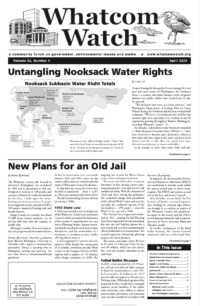by Eric Hirst
Editor’s Note: See the front page article, “Untangling Nooksack Water Rights,” written by Luisa Loi in this April issue for more information regarding adjudication.
Craig MacConnell, in the March 2023 issue of Whatcom Watch suggests: “Here is what will happen to the [farm]land – houses, more and more spread out, expensive for public services, houses.” This is a grim picture of the demise of Whatcom farming. But, that is definitely not the only future possible. My sense of farmers is that they are practical and resilient. Here are some ideas on how they can prepare for a productive, profitable, and sustainable agriculture with less water. My focus is on water-use efficiency (WUE), a resource that has been largely ignored for Whatcom agriculture.
It is almost certain that Whatcom farmers will have much less water to irrigate their crops in the coming years and decades. I’m confident in this prediction because of two factors: climate change and adjudication of water rights in the Nooksack River basin.
The effects of climate change, already apparent, include less snow and more rain in the winter, earlier snowmelt in the spring, lower summer streamflows throughout the basin, and higher summer temperatures and less rain. These changes both reduce the supply of water for human use and increase the demand for irrigation water.
Adjudication is a legal process, set to begin formally later this year, to determine who has the right to use water, how much, where, for what purpose(s) and when. The two local tribes, Lummi Nation and Nooksack Indian Tribe, hold the most senior and likely largest rights. Neither tribe has indicated yet how much water they think they are entitled to for (1) minimum instream flows to support salmon and other wildlife, and (2) on-reservation uses. To further complicate matters for farmers, roughly half the water they now use lacks legal authorization.
How should farmers respond to these two challenges to their use of water?
• Review past and ongoing programs aimed at improving irrigation WUE, including those in Washington state, California, and the Colorado River Basin. The goal here is to build on past successes and avoid past mistakes in designing and implementing WUE programs in Whatcom County.
• Support demonstrations of improved irrigation technologies and practices as they apply to Whatcom County. The preferred technologies, irrigation scheduling and maintenance approaches will vary, depending on crop type, soil type, weather conditions, past practices and other factors.
• Install water meters on a representative sample of farms and report aggregate data to the public on actual (not estimated) water use by month and crop. Although some farmers do meter their water use, that information is not made public. Further, the various analytical methods used to estimate water use differ substantially and have not been validated with real-world data from northwest Washington. Absent metering, there is no way to ensure that farmers use no more water than that allowed by their rights.
• Work with the two Tribes, Ecology and state Legislature to eliminate relinquishment (the use-it-or-lose-it element of state water law), a barrier to improving agricultural WUE. For example, farmers could agree that some portion of the water that would otherwise be lost because of relinquishment can be assigned to instream flows. Or, farmers could provide additional ecosystem services, such as larger streamside buffers, in exchange for relief from relinquishment.
• Conduct pilot programs to determine whether and how WUE works for farmers. Use water-meter data to document the benefits and costs of improved irrigation technologies, better maintenance practices for irrigation equipment, and sophisticated irrigation scheduling methods. Initial efforts should focus on better methods to decide when and how much to irrigate. Use of such software requires no new capital equipment (only a smartphone and internet connection), could save 10 to 20 percent of the water now used by farmers, and is rarely used. If for example, a local entity (e.g., Whatcom Family Farmers, Ag Water Board, or Whatcom Conservation District) trained the managers of the 100 largest farms in Whatcom County, this would affect about 40,000 acre-feet/year, more water than all Whatcom households, combined, use. Workshops aimed at these large landowners might save a few thousand acre-feet a year with no loss in productivity.
• Possibly increase the amount of dryland farming. Roughly 25,000 acres of Whatcom farmland are not irrigated. Rainfall provides the moisture needed to grow grass for hay and for pasture. Perhaps dryland farming can be profitably expanded as water supplies become tighter and tighter.
• Other options farmers might consider include switching to crops that are less water intensive, increasing soil organic matter (so that the soil can retain more moisture), deploying new technologies to better manage water use (satellite imagery, drones, soil-moisture sensors), or fallowing land with poor-quality soils.
Whatcom farmers are a critical part of our water-supply problems because they use so much water during the summer. They are also an essential part of the solution, again because they use so much water. These problems can be resolved. However, they require farmers to be flexible and to accept the certainty of climate change and the near-certainty of adjudication. And, the rest of the community (tribes, City of Bellingham, PUD #1, Whatcom County, Ecology, Whatcom Conservation District, and others) should provide technical and financial assistance to farmers during this transition to a more efficient, sustainable water and agricultural future.
_______________________
Eric Hirst has a Ph.D. in engineering from Stanford University, worked at Oak Ridge National Laboratory for 30 years as a policy analyst on energy efficiency and the structure of the electricity industry. He spent the last eight years of his career as a consultant.




























